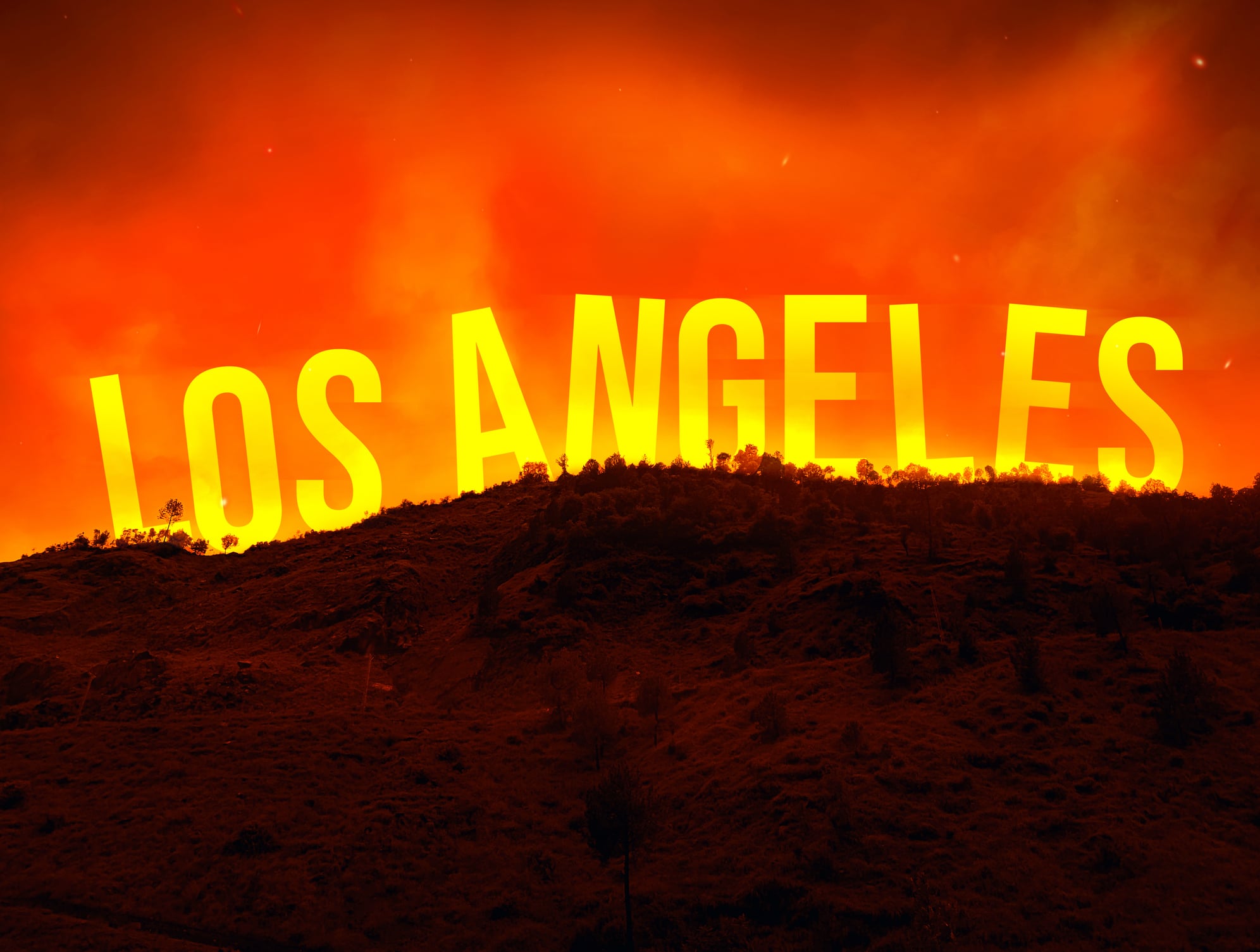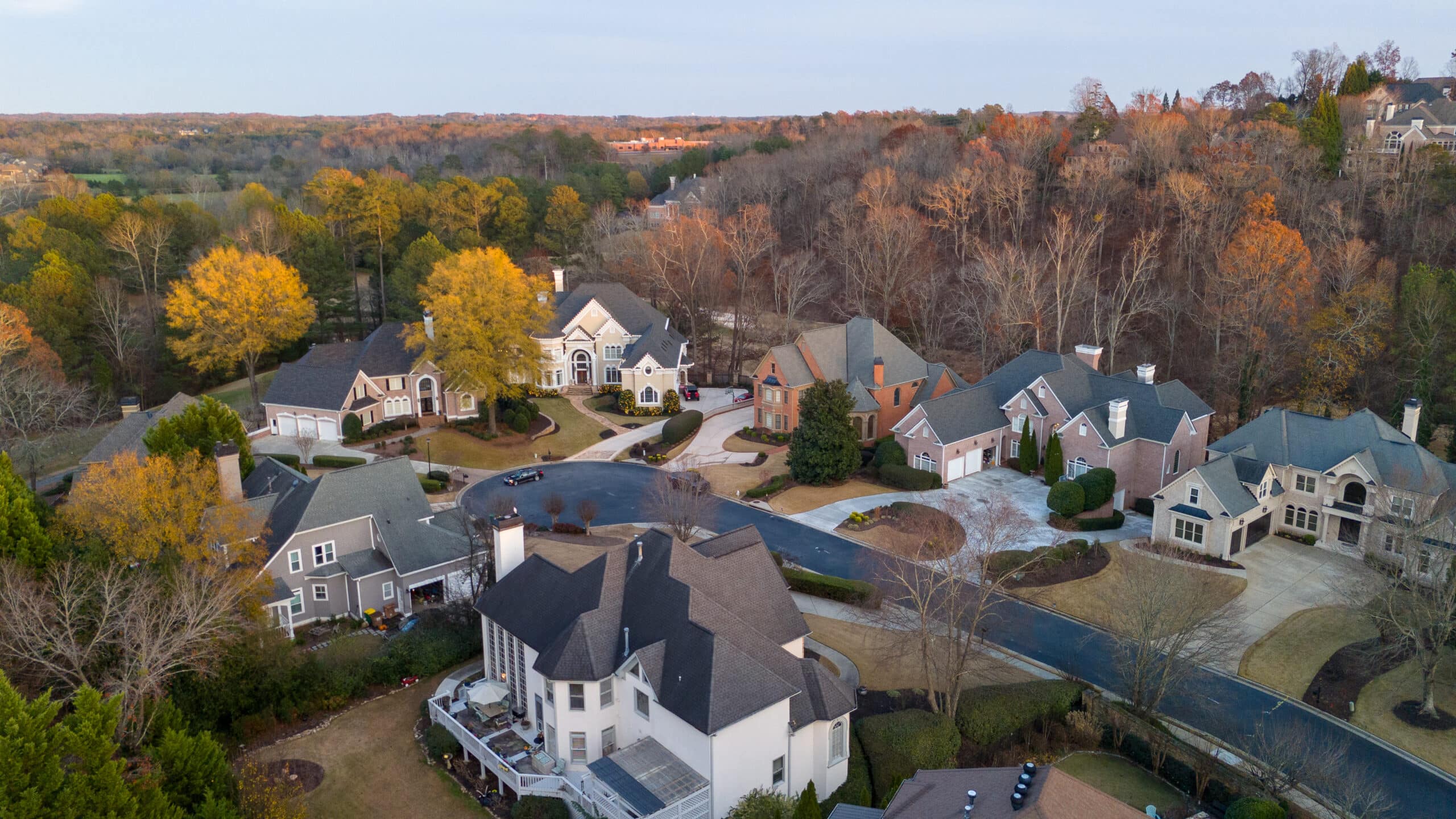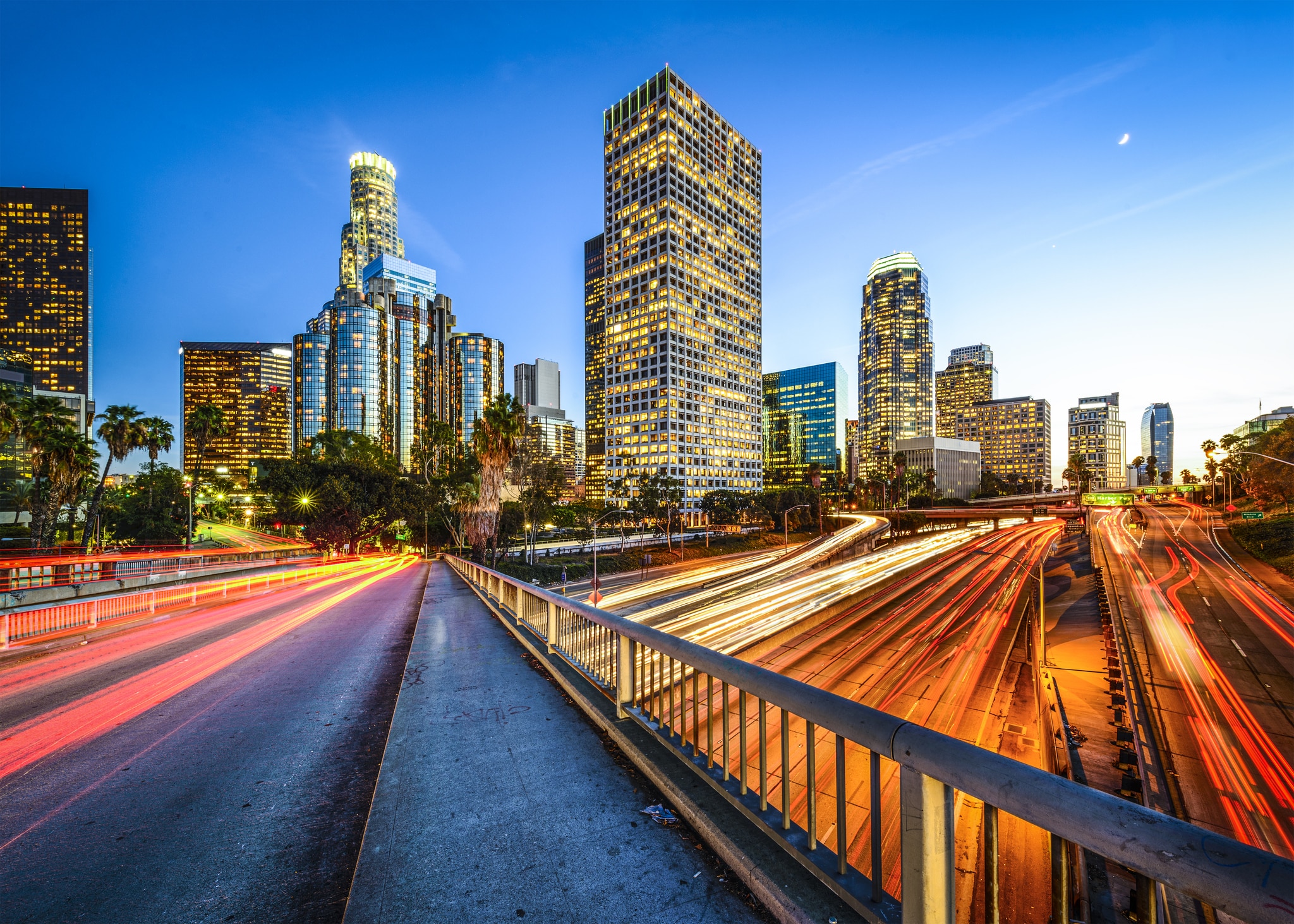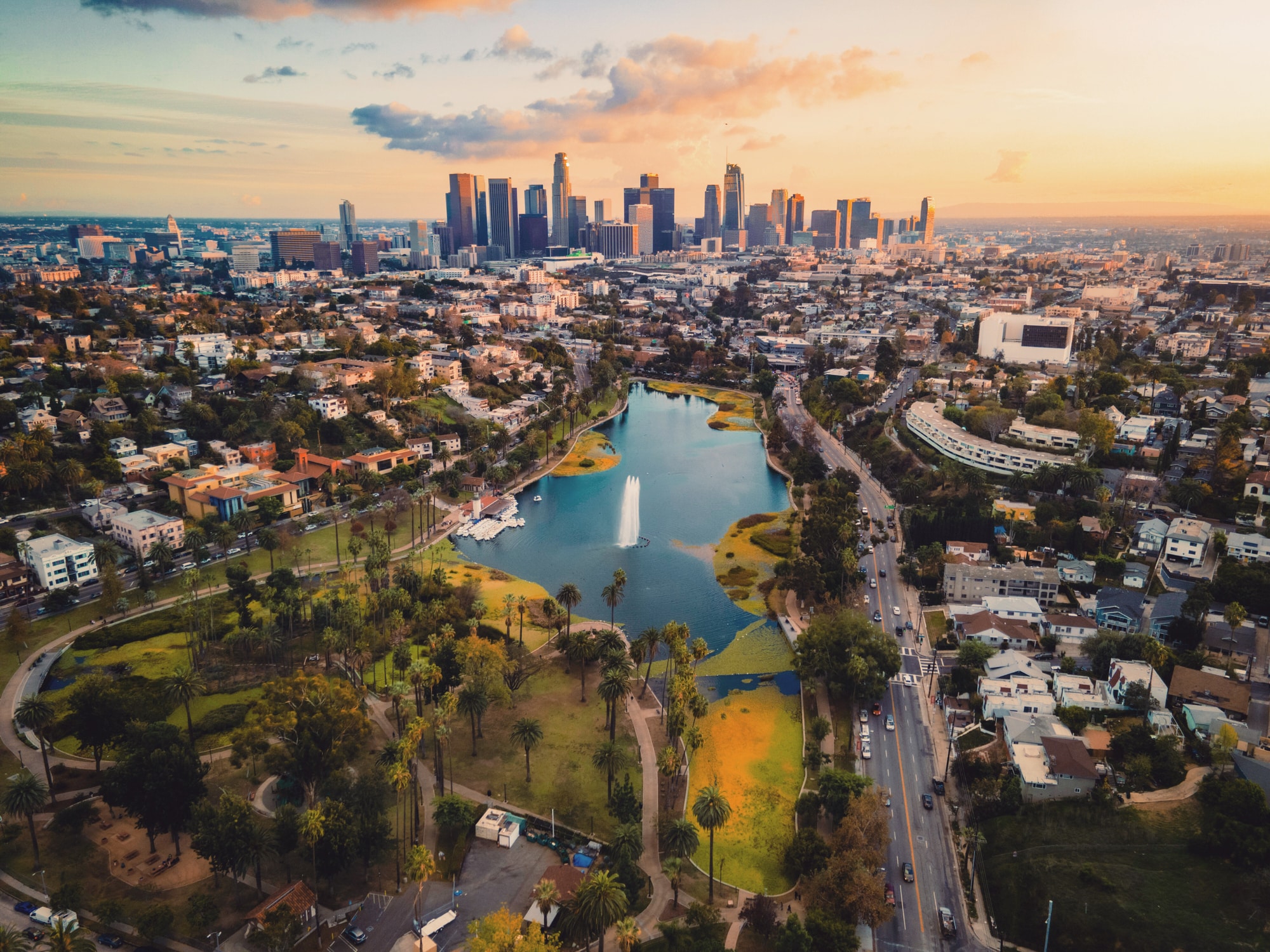From the sunny promenades of Venice Beach to the cinematic thoroughfares of Hollywood to the mountainous terrain of Griffith Park, Los Angeles is one of the world’s most captivating cities. No wonder more than 12 million residents call this metropolis home. Does moving to Los Angeles sound like an Oscar-worthy adventure? You’re in luck, California Dreamer — this guide has all you need to know about the pros and cons of living in Los Angeles.
LA’s legendary entertainment, diverse cultural scene, and warm year-round climate particularly attract folks from other parts of California, as well as the Midwest, Northeast, and Pacific Northwest. Ready to join their ranks and embrace those Tinseltown vibes? Before you start packing, here’s what to consider — from the cost of living in Los Angeles and the current L.A. job market, to the best places to live in Los Angeles and the iconic, must-see attractions.
Living in Los Angeles: Quick Facts
Population: 12,678,000 (6.4% increase from 2024)
Median Age: about 38 years old
Cost of Living: 50% above the national average
Median Income: $79,700
Average Home Value: $973,400
Average Rent: $2,730 per month
Fun Fact: 2028 will mark the third time LA hosts the Olympic Games, making it one of three cities to ever reach this milestone (the other two being London and Paris).
What To Know About Living in Los Angeles (Before You Move)
Whether you’re relocating from another part of California, or you’re moving from New York to California, life in the City of Angels is a unique experience like no other. On that note, we’ve compiled a list of the top 10 things to know before moving to Los Angeles, so you can determine if this sun-bleached urban oasis is right for you. Let’s dive in!
1) The cost of living in Los Angeles is well above the national average
The mystique of L.A.’s silver screen charisma and 75-mile Pacific coastline don’t come cheap — in fact, the cost of living in Los Angeles is 50 percent higher than the national average. A family of four needs to earn $272,000 per year to live comfortably here, while a single person needs to earn $115,700.
An inflated housing market and the country’s highest state income taxes make L.A. undeniably expensive. But with that said, if you’re moving from New York to Los Angeles, your cost of living will decrease by almost 30 percent.
2) Los Angeles is known for its balmy weather — no matter the season
L.A. has a Mediterranean climate with about 285 days of sunshine and less than 20 inches of rainfall per year. The mild winters are short, with temperatures between 45–65 degrees, while the arid summers are long and warm, with temperatures hovering at about 75–85 degrees. This city also experiences Santa Ana winds in the cooler seasons (September through May). These high-pressure systems cause temperatures to rise, especially in the winter, which can increase the wildfire risk across Los Angeles and all of Southern California.

3) Natural disasters have become increasingly common in Los Angeles
It’s important to know that natural disasters are a fact of life here in Los Angeles — but some are more concerning than others. For instance, earthquakes are such a common occurrence that many Angelenos aren’t even fazed by them, whereas the recent wildfires that swept across L.A. county in 2025 left over 58,000 acres of destruction in their wake. This doesn’t necessarily have to deter you from moving to Los Angeles, but here’s what to be aware of.
Droughts
L.A.’s semi-arid climate with below-average rainfall contributes to frequent drought conditions. Not only will a drought exacerbate the risk of wildfires, it can also cause a respiratory infection called Valley Fever. This illness is particularly common in areas like the Antelope and San Fernando Valleys, both of which are prone to dust, smog, and poor air quality.
Wildfires
The combination of warm temperatures, dry weather, and Santa Ana winds make Los Angeles extremely vulnerable to wildfires. Although peak wildfire season is usually between August and October, these natural disasters can occur anytime. The Eaton and Pacific Palisades Fires that ravaged L.A. in January 2025 are a clear example of this perennial threat.
Earthquakes
Southern California has about 10,000 earthquakes per year, and most of them occur in the Los Angeles Basin. That’s because L.A. is situated near the 750-mile San Andreas Fault, one of the most seismically active plate boundaries on Earth. While most earthquakes in this area are too small to detect, about 15–20 can surpass a considerable magnitude of 4.0.
Mudslides
When heavy rainfall occurs in Los Angeles after a period of intense drought, the water quickly saturates all that parched soil, causing it to destabilize and loosen. This erosion can result in mudslides, especially in mountainous areas like Malibu and in places like Altadena or the Pacific Palisades, where the soil already has burn scars from recent wildfires.
4) Crime rates in Los Angeles tend to be higher than other U.S. cities
Given L.A.’s enormous population density, it won’t come as much of a surprise that crime rates here outpace many other cities. In 2024, about 3,670 crimes were committed per every 100,000 residents versus the state average of 2,830 and the national average of 2,280.
Fortunately, Los Angeles has seen less violent crimes in recent years, and most criminal activity is concentrated within specific areas. Below are three of the safest neighborhoods in L.A. — and three neighborhoods where crimes are likely to occur.
Safest Neighborhoods in Los Angeles
Bel Air
Sherman Oaks
Brentwood
Most Dangerous Neighborhoods in Los Angeles
Skid Row
Lincoln Heights
South L.A.
5) Los Angeles has a diverse job market full of sought-after industries
It’s no secret that Los Angeles has faced economic setbacks due to inflation and the Hollywood labor strikes of 2023, but the city’s GDP is projected to accelerate by over two percent in 2025, and job openings will increase by 0.7 percent. In fact, one of the main reasons so many people move to L.A. is because of all the exciting career opportunities here.
L.A. has the world’s twentieth largest economy with tons of diverse, profitable industries. Think: entertainment, digital media, aerospace, real estate, hospitality, tourism, education, international trade, finance, biosciences, technology, healthcare, food services, transportation, fashion, and more. The unemployment rate is 5.8 percent, but about 45,000 new jobs were created within the last year, which bodes well if you’re relocating for a job.
Based on where you’ll be moving to Los Angeles from, you could also see an income boost. The average salary here is around $90,320 per year ($43 per hour) — more than you’ll earn in places like Denver, Phoenix, Houston, and Salt Lake City. It’s higher than the California state average, too. While there’s no doubt living in Los Angeles can be expensive, it’s booming with potential to advance your career goals as well.
6) The home values and rental prices in Los Angeles are a mixed bag
Before you move to Los Angeles, keep in mind this city has one of the most inflated housing markets in the U.S. Factors such as increased buyer competition, limited real estate inventory, and mass displacement from the January 2025 wildfires are causing home values to escalate. On average, a house will cost around $973,400 (1.6 percent increase from last year), or if you’re looking to rent, a one-bedroom apartment will cost $2,730 per month.
So, can you live in L.A. for cheap? It’s all a matter of where you choose to put down roots. While the cost of living in Los Angeles tends to be steeper than most cities, some parts of town are more affordable than others. For context, here’s a quick rundown of the home values and rental prices in a few L.A. neighborhoods, from least to most expensive.
Average Home Values in Los Angeles Neighborhoods
Pico-Union: $490,000
Downtown: $585,000
Exposition Park: $835,000
Arlington Heights: $935,000
East Hollywood: $1,100,000
Brentwood: $3,100,000
Average Rent in Los Angeles Neighborhoods

7) The best places to live in Los Angeles have something for everyone
Regardless of where you settle down, this city’s unique, vibrant neighborhoods (all 272 of them, to be exact!) make L.A. a fantastic place to live. But with so many options to sort through, how can you determine which is the right choice?
Whether you prefer an urban neighborhood central to the action or a suburban neighborhood with palm tree-flanked streets, here are our top three contenders for the best places to live in Los Angeles.
Sherman Oaks: Best for families
Nestled in the San Fernando Valley less than 20 miles from the urban core, Sherman Oaks is one of the best neighborhoods in L.A. to raise a family. This suburban enclave feels quiet and safe, while community events like the annual Sherman Oaks Street Fair lend it a welcoming vibe. This neighborhood also has highly rated public schools and numerous housing options, from historic bungalows to modern townhomes to sprawling estates.
Sherman Oaks is close to major interstates, so the perks of city living are still accessible when you need them. Looking for entertainment the whole family will love? Check out the Sherman Oaks Galleria, an open-air lifestyle center with over 35 shops and restaurants, a movie theater, and seasonal events. Kids of all ages are sure to enjoy the sports facilities, nature trails, and other outdoor activities at Van Nuys Sherman Oaks Recreation Center too.
Downtown: Best for young professionals
Downtown Los Angeles (DTLA) is the city’s main financial and commercial hub, making it an ideal environment for young professionals. Commuters will love DTLA for its transit score of 98 and walk score of 93, while entrepreneurs, freelancers, and remote employees will benefit from all the co-working spaces, many of which connect to high-rise apartments.
This urban mecca is also known for its trendy nightlife spots, dynamic cultural attractions, elite sports teams, and global cuisine. Treat your taste buds to fish tacos at La Tostaderia in Grand Central Market or ramen at Daikokuya in Little Tokyo. Peruse the diverse galleries, museums, and performance venues in the Arts District. Relax over a game of billiards, cocktails, and live jazz at Rhythm Room. Or cheer on the LA Lakers at Crypto.com Arena. Whatever you’re in the mood for, DTLA offers just the right mix of work and play.
Brentwood: Best for retirees
If you want to retire in Los Angeles, look no further than Brentwood — this walkable village about 15 miles from Downtown has all the comforts and amenities of an upscale community, along with the relaxed ambiance that makes Southern California such a desirable place to ease into those golden years. Not to mention, Brentwood has excellent healthcare facilities and homes to suit all preferences, such as luxury condos, single-family houses, and convenient 55+ developments. It also boasts one of the lowest crime rates in Los Angeles.
No matter where your interests lie, Brentwood features numerous attractions, from the Getty Museum for arts and culture enthusiasts to the Crestwood Hills Recreation Center for nature lovers. And that only begins to scratch the surface of all this area has to offer. Meander through the Brentwood Farmers Market, showcasing artisan makers and gourmet food purveyors. Enjoy free live music performances at the Starry Nights in Brentwood summer concert series. Or sip on a latte from Caffe Luxxe while you shop the eclectic boutiques at Brentwood Country Mart. This peaceful neighborhood has all you need for a fulfilling retirement.
8) Moving to Los Angeles means access to unlimited entertainment
One of the best parts about living in Los Angeles is the sheer amount of fun activities at your fingertips. From athletic events and artistic showcases to nature spectacles and culinary wonders, there’s no shortage of entertainment here.
Honestly, this list could just continue on for several pages, but here are the top 20 attractions every Angeleno should check out:
Hike to the Griffith Observatory for panoramic views of the entire L.A. skyline.
Enjoy the food trucks and street performers along the Venice Beach Boardwalk.
Rent a swan boat and catch the sunset while you float along Echo Park Lake.
Savor global delicacies at Smorgasbord L.A., the nation’s largest open-air food market.
Browse over 560 collections of historic and contemporary art at the Getty Museum.
See any of L.A.’s 12 professional sports teams in action at their packed home games.
Wander through a 150-acre urban oasis of native blooms at Descanso Gardens.
Explore the nature trails at Runyon Canyon State Park in the Santa Monica Mountains.
Snap a selfie by the iconic Hollywood Sign tucked in the hills of Griffith Park.
Marvel at the Los Angeles County Museum of Art’s urban light installation.
Tickle your taste buds at the L.A. Farmers Market’s 100+ restaurants and grocers.
Get behind-the-scenes access to legendary film and TV sets on a studio tour.
Head over to Anaheim and unleash your inner child at Universal Studios or Disneyland.
Savor a pint at Arts District Brewing Company after perusing the local street murals.
Check out the elaborate storefronts and lavish designer boutiques on Rodeo Drive.
Celebrate the annual Nisei Week Japanese Festival in Little Tokyo each summer.
Experience the comedy clubs, music venues, and nightlife spots on the Sunset Strip.
Soak up the sun at all 20 beaches in L.A., from Malibu Surfrider to Marina Del Rey.
Catch a movie at the TCL Chinese Theatre, a Hollywood institution for almost 100 years.
Discover the stories behind classic films at Academy Museum of Motion Pictures.

9) The film, music, and television scene in Los Angeles is simply iconic
We can’t talk about L.A. without paying tribute to its storied influence on the film, music, and television industries. The City of Angels has been hailed as an entertainment capital since the early 1900s when silent films hit the silver screen. This cinematic breakthrough put Tinseltown on the map, and by the 1920s, filmmakers were busy transforming L.A. into a mecca for studios like Paramount, Walt Disney, Universal, and Warner Brothers. More than a century later, Los Angeles is still the epicenter of movie magic, full of nostalgic film landmarks.
Music was next to emerge as a Hollywood cultural touchstone — from the movie musical era of the 1950s and to the folksy “California Sound” aesthetic of the 1960s, to the hip-hop revolution of the 1980s–1990s and to the indie electronic scene of today. L.A. also has a vibrant tradition of music festivals, like the annual Camp Flog Gnaw Carnival at Dodger Stadium, featuring an eclectic lineup of R&B and hip-hop artists. The city is home to famous labels as well, such as Capitol Records, Def Jam Recordings, Delicious Vinyl, and Warner Records.
Television also entered the L.A. zeitgeist in the mid-1950s as TV studios began to relocate from New York to Hollywood. But it took off during the 1960s, with an influx of sitcoms being filmed on production lots in Studio City. Los Angeles has also been at the forefront of numerous evolutions in this medium, such as late night talk shows, unscripted reality series, and streaming platforms. For an immersive TV experience, you can still tour the original L.A. sets and locations of classic shows like Friends, Gilmore Girls, The Big Bang Theory, and more.
10) Consider Los Angeles your launchpad to other cool destinations
While the City of Angels is a premier destination on its own, living here also makes it easier to explore other alluring cities and states on the West Coast — whether you catch a flight at the LAX international airport (less than 20 miles from Downtown) or hop on one of a dozen convenient freeways for an unforgettable trip to these bucket list–worthy locations.
Honolulu, HI: 6-hour flight from LAX
Seattle, WA: 3-hour flight from LAX; 17.5-hour drive on I-5 N
Portland, OR: 2.5-hour flight from LAX; 15-hour drive on I-5 N
Bend, OR: 2-hour flight from LAX; 13-hour drive on I-5 N
Lake Tahoe, CA: 7.5-hour drive on US-395 N
Sedona, AZ: 7-hour drive on I-10 E
Grand Canyon, AZ: 7-hour drive on I-40 E
San Francisco, CA: 6-hour drive on I-5 N
Yosemite, CA: 5-hour drive on CA-99 N
Las Vegas, NV: 4-hour drive on I-5 N
Palm Springs, CA: 2-hour drive on I-10 E
San Diego, CA: 2-hour drive on I-5 S
Pros and Cons of Living in Los Angeles
As you can see, living in Los Angeles comes with hard-to-resist selling points — but just like anywhere else, it also has some potential drawbacks. So, before you move out here, first consider the main pros and cons of living in Los Angeles.
Pros of Living in Los Angeles
The weather is sunny and warm almost all year round.
The diverse entertainment options are unbeatable.
The economy is strong with a wide range of industries.
The commute to other cities is easy and accessible.
The best places to live in Los Angeles will suit any preference.
Cons of Living in Los Angeles
The cost of living in Los Angeles is acutely expensive.
The home and rental prices continue to increase.
The crime rate is above the national average.
The natural disasters can be frequent and intense.

Ready to Move to L.A.?
If perennial sunshine, phenomenal entertainment, and pristine beaches sound like your dream come true, and you can afford the home prices, then moving to Los Angeles is so worth it — especially if you’re from a state with an even steeper cost of living.
When it’s time to make your L.A. debut, Colonial Van Lines can streamline the process. With over 50 years of experience, we’ve fine-tuned each step of long-distance relocation — from packing up your old house to transporting, unloading, and unpacking. Contact us for a free moving quote, and let’s turn this California dream into a reality!

